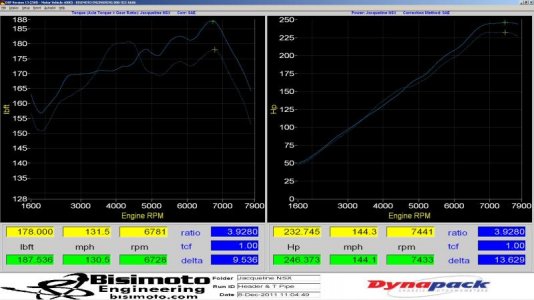- Joined
- 4 January 2017
- Messages
- 15
Hi all,
It's always bothered me a little that a Honda VTEC engine should be entirely capable of making 100bhp/litre, but that the 3-litre version in the NA1 doesn't hit that magic number.
Replacing the cast-iron OEM exhaust manifold with tubular headers seems to be the best first step to set about righting this wrong, but the price ranges are huge. RFY and Fujitsubo make works of art that I'd be proud to hang on the wall but might make my bank manager unhappy; OBX make an almost suspiciously inexpensive offering that from reading feedback I'm not too keen on . . .
Pride seem to make a very reasonably priced header to a decent design, and actually include dyno charts, which I applaud them for!
However, the before and after dyno chart shows up an interesting point I hadn't expected. Not so much for the 'after' curve, but for the 'before' - there appears to be a great big lump of torque present between 3500-4500rpm with the stock manifolds that then goes away once the headers are installed.

Satisfying my OCD by installing headers to push the peak power up is all very well, but on the street I use the midrange torque from 3500-4500rpm far more than I'd ever use peak power - on the basis of these curves I might actually lose out on that deal!
So the question - is the Pride dyno chart actually representative? Is there some special secret sauce in the OEM manifolds that causes the apparent bump in torque in the midrange?
Inputs welcome!
It's always bothered me a little that a Honda VTEC engine should be entirely capable of making 100bhp/litre, but that the 3-litre version in the NA1 doesn't hit that magic number.
Replacing the cast-iron OEM exhaust manifold with tubular headers seems to be the best first step to set about righting this wrong, but the price ranges are huge. RFY and Fujitsubo make works of art that I'd be proud to hang on the wall but might make my bank manager unhappy; OBX make an almost suspiciously inexpensive offering that from reading feedback I'm not too keen on . . .
Pride seem to make a very reasonably priced header to a decent design, and actually include dyno charts, which I applaud them for!
However, the before and after dyno chart shows up an interesting point I hadn't expected. Not so much for the 'after' curve, but for the 'before' - there appears to be a great big lump of torque present between 3500-4500rpm with the stock manifolds that then goes away once the headers are installed.

Satisfying my OCD by installing headers to push the peak power up is all very well, but on the street I use the midrange torque from 3500-4500rpm far more than I'd ever use peak power - on the basis of these curves I might actually lose out on that deal!
So the question - is the Pride dyno chart actually representative? Is there some special secret sauce in the OEM manifolds that causes the apparent bump in torque in the midrange?
Inputs welcome!







